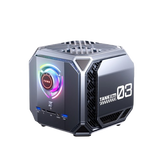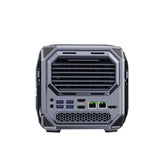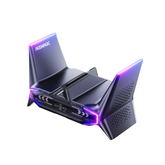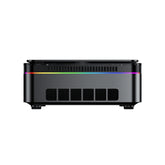How to Choose, Maintain, and Optimize Your SSD in 2025

With the advancement of technology, the demand for data storage continues to grow. Traditional hard disk drives (HDDs) are gradually being replaced by faster, more reliable solid-state drives (SSDs). Unlike HDDs, which rely on spinning disks and read/write heads, SSDs store data using flash memory chips, eliminating mechanical components. This fundamental difference gives SSDs significant advantages in speed, durability, and power efficiency. Whether for everyday office tasks, gaming, or professional content creation, upgrading to an SSD can dramatically improve system responsiveness and overall performance.
In recent years, the price of SSDs has steadily declined, making them more accessible to a wider audience. From standard mini PCs and laptops to high-performance servers, SSD adoption has surged across various devices to meet increasing storage demands. Benefits such as faster boot times, smoother application performance, lower power consumption, and quieter operation make SSDs the preferred choice for modern storage solutions.
This article will dive deep into how SSDs work, the different types available, their pros and cons, and key factors to consider when purchasing an SSD. By the end, you'll have a clearer understanding of SSD technology and how to choose the right SSD for your specific needs.
How SSDs Work
Solid-state drives (SSDs) utilize NAND flash storage technology to read and write data, whereas traditional HDDs rely on spinning disks and mechanical read/write heads. The fundamental difference in data storage methods is what makes SSDs far superior to HDDs in terms of speed and reliability.
Unlike HDDs, which require the read/write head to move across a rotating platter to locate data, SSDs use NAND flash memory cells to access data electronically with no moving parts. This enables SSDs to deliver significantly faster read and write speeds, while also reducing physical wear and tear, enhancing overall longevity.
To optimize performance, SSDs rely on an integrated controller that manages data allocation and retrieval, along with DRAM cache for temporary storage and acceleration. Unlike HDDs, which suffer from latency due to mechanical movement, SSDs leverage parallel data access, drastically reducing response times and improving multitasking efficiency.
Additionally, SSDs support the TRIM command, which helps clear unused data blocks, enhancing write performance and extending lifespan. SSDs using the NVMe protocol take advantage of PCIe lanes to achieve much higher bandwidth compared to SATA SSDs. This makes NVMe SSDs the ideal choice for high-performance computing, gaming storage, and professional workloads that demand ultra-fast data transfers.
Types of SSDs

As SSD technology continues to evolve, various types of SSDs have emerged to cater to different devices and usage scenarios. Based on interface, performance, and form factor, SSDs can be categorized into the following types:
SATA SSD: Affordable Upgrade for Traditional SATA Devices
SATA SSDs were the first widely adopted solid-state drives, utilizing the SATA interface with maximum speeds of around 550MB/s—3 to 5 times faster than traditional HDDs. Due to their broad compatibility with older laptops and desktops, SATA SSDs remain a budget-friendly option for users transitioning from HDDs.
NVMe SSD (PCIe SSD): High-Performance Storage Solution
NVMe SSDs leverage the PCIe interface, offering significantly higher bandwidth compared to SATA SSDs. With data transfer speeds reaching 3000MB/s or even higher, NVMe SSDs are ideal for high-performance computing, gaming, and video editing. Thanks to advanced parallel processing technology, NVMe SSDs drastically reduce data access latency, making them the preferred choice for modern high-speed storage solutions.
M.2 vs 2.5-inch SSD: Space and Compatibility Comparison
- M.2 SSD – Directly plugs into the motherboard’s M.2 slot, eliminating the need for cables. Available in both SATA and NVMe versions, M.2 SSDs are compact and perfect for ultrathin laptops and high-performance desktops.
- 2.5-inch SSD – Uses the SATA interface and shares the same form factor as traditional HDDs, making it ideal for older laptops and desktops that lack an M.2 slot. It’s also easier to install.
Portable SSD: High-Speed External Storage
Portable SSDs connect via USB or Thunderbolt, offering high-speed data transfer, durability, and portability. These are perfect for backing up large files, video editing, and data migration. Popular models like the Samsung T7 and SanDisk Extreme provide an excellent alternative to traditional external HDDs.
Pros and Cons of SSDs
Solid-state drives (SSDs) have become the preferred storage solution due to their exceptional performance. However, compared to hard disk drives (HDDs), SSDs still have some limitations. Below are the key advantages and disadvantages of SSDs:
✅ Advantages of SSDs
✔ Blazing-Fast Read & Write Speeds – Compared to HDDs, SSDs offer 3-5× faster read speeds, reducing boot times by over 50% and enabling quicker application and game loading for an enhanced user experience.
✔ Lower Power Consumption & Silent Operation – With no moving parts, SSDs consume less power, making them ideal for laptops by extending battery life. Additionally, SSDs operate silently, making them a great choice for quiet office environments and data centers.
✔ Shock Resistance & Durability – Unlike HDDs, which rely on spinning disks and read/write heads that can fail due to physical impact, SSDs have no moving parts and are significantly more resistant to shocks, ensuring better data protection and longevity.
✔ Superior Performance for Gaming & Video Editing – In gaming and professional software applications, SSDs reduce loading times and enhance system fluidity. They particularly shine in 4K video editing, high-end gaming, and 3D rendering, where speed and responsiveness are critical.
❌ Disadvantages of SSDs
✖ Higher Cost Per GB – SSDs remain more expensive per gigabyte compared to HDDs. Although prices have steadily dropped, high-capacity SSDs (2TB and above) still come at a premium.
✖ Limited Lifespan – SSDs rely on NAND flash memory cells, which have a finite number of write cycles (Total Bytes Written, TBW). While modern SSDs employ wear-leveling and endurance optimization techniques to extend lifespan, users performing high-intensity write operations should monitor SSD health over time.
Is an SSD Worth Buying?
Overall, SSDs outperform HDDs in terms of speed, power efficiency, and durability, making them the superior choice for laptops, gamers, creative professionals, and enterprise storage. Although cost remains a factor, the performance gains make SSD upgrades a worthwhile investment.
For most users, SATA SSDs provide an affordable and effective upgrade, while NVMe SSDs are the go-to solution for those demanding maximum speed and efficiency.
How to Choose the Right SSD
Selecting the right SSD requires careful consideration of usage scenarios, storage capacity, interface compatibility, and brand reliability. Here are the key factors to consider:

📌 Usage Analysis: SSD Recommendations for Different Users
- Gamers – NVMe SSD (PCIe 4.0 or higher) is recommended to significantly reduce game loading times and enhance smoothness. Consider options like Samsung 990 Pro or WD Black SN850X.
- Content Creators (Video Editing / 3D Rendering) – Large-capacity, high-speed SSDs are essential. 1TB+ NVMe SSDs accelerate large file processing. Consider Crucial P5 Plus or Kingston KC3000.
- General Office Users – SATA SSDs are sufficient for everyday tasks. A 512GB or 1TB Samsung 870 EVO offers high compatibility and great value for money.
📌 Recommended SSD Capacity Based on Usage Scenarios
- 256GB – Suitable for basic office tasks (documents, browsing, light applications) but offers limited storage, not ideal for long-term use.
- 512GB – Ideal for office work and casual gaming, with enough space for photos and videos.
- 1TB – Recommended for gamers and content creators, capable of storing multiple large applications, high-resolution videos, and game files.
- 2TB and above – Best for high-end users, video editing professionals, and heavy data storage needs, ensuring maximum flexibility and performance.
📌 Interface & Compatibility: SATA vs NVMe vs PCIe vs M.2
- SATA SSD – Highly compatible with older devices, such as Samsung 870 EVO.
- NVMe SSD (PCIe 3.0/4.0/5.0) – Significantly faster than SATA SSDs, perfect for high-performance laptops and desktops. Consider WD Black SN850X.
- M.2 vs 2.5-inch – M.2 SSDs are more suitable for ultrathin laptops, whereas 2.5-inch SSDs are better for desktop PCs and older laptops.
- PCIe 5.0 SSDs (e.g., Crucial T700) – Designed for the latest high-end motherboards, offering over 12,000MB/s speeds, though currently expensive.
SSD Maintenance & Optimization
To maintain high performance and extend the lifespan of an SSD, users should implement several optimization measures, including enabling TRIM, reducing unnecessary write operations, updating firmware regularly, and configuring Over-Provisioning (OP). Below are specific recommendations:
✅ Enable TRIM for Efficient Garbage Collection
TRIM is a crucial SSD optimization feature that notifies the SSD to free up storage space after deleting data, improving garbage collection efficiency. Enabling TRIM helps maintain stable write performance while reducing wear on storage cells, thereby extending the SSD’s lifespan.
Most modern operating systems (Windows, macOS, Linux) support TRIM by default, but users can verify its status in Windows by running: fsutil behavior query DisableDeleteNotify.
✅ Minimize Frequent Large Write Operations to Reduce NAND Flash Wear
Since SSDs use NAND Flash memory, each storage cell has a limited number of write/erase cycles. To prevent premature wear, avoid frequent large write operations:
- Avoid repeatedly downloading/deleting large files (e.g., 4K videos, game patches).
- Do not use SSDs as high-load cache drives, such as scratch disks for video editing or high-frequency database storage.
- Disable Windows Disk Defragmentation, as SSDs do not require defragmentation—it only generates unnecessary write cycles.
✅ Regularly Update SSD Firmware for Stability & Compatibility
SSD manufacturers periodically release firmware updates to fix bugs, improve compatibility, and optimize SSD controller operations. Users should check for updates via official software such as:
Updating the firmware ensures the SSD runs at its optimal performance and reliability.
✅ Enable Over-Provisioning (OP) for Longevity & Performance
Over-Provisioning (OP) reserves a portion of SSD storage space for the controller to manage data more efficiently, optimizing performance and reducing Write Amplification. While most SSDs have built-in OP, users can manually adjust it:
- Leave 10-20% of the SSD space unallocated to improve garbage collection and wear leveling.
- High-end SSDs (e.g., Samsung 970 EVO Plus) allow OP settings to be adjusted via official software, further enhancing lifespan and stability.
💡 Summary: How to Keep Your SSD Running Efficiently?
To ensure long-term stability and speed, follow these key practices:
✔ Enable TRIM ✔ Minimize frequent large data writes ✔ Regularly update firmware ✔ Reserve Over-Provisioning space
Proper maintenance boosts SSD performance and prolongs its lifespan, ensuring a reliable storage experience.
Conclusion
SSD technology has become the dominant storage solution due to its ultra-fast speeds, low power consumption, noiseless operation, and superior durability, gradually replacing traditional HDDs.
When selecting an SSD, choose the right type and capacity based on your needs:
- Everyday Office & Light Usage – 512GB SATA SSD (e.g., Samsung 870 EVO).
- Gamers & High-Performance Users – 1TB+ NVMe SSD (e.g., WD Black SN850X).
- Professional Creators & Data-Intensive Work – 2TB+ PCIe 4.0/5.0 SSD (e.g., Crucial T700).
To keep your SSD running efficiently over time, enable TRIM, reduce unnecessary writes, update firmware regularly, and configure Over-Provisioning properly.
FAQs
What is the difference between SATA SSD and NVMe SSD?
The primary difference between SATA SSDs and NVMe SSDs lies in their interface and speed. SATA SSDs use the older SATA interface, offering speeds up to 550MB/s, while NVMe SSDs use the PCIe interface, allowing data transfer speeds that can exceed 3000MB/s. This makes NVMe SSDs significantly faster and more suitable for tasks requiring high performance, such as gaming, video editing, and data-heavy applications.
Do I need to defragment my SSD like an HDD?
No, defragmenting an SSD is unnecessary and could actually reduce its lifespan. Unlike HDDs, which benefit from defragmentation due to mechanical read/write heads, SSDs have no moving parts. The operating system manages data efficiently without fragmentation. In fact, Windows disables defragmentation for SSDs by default. It is best to focus on regular maintenance tasks, such as enabling TRIM and updating firmware.
How can I extend the lifespan of my SSD?
To extend the lifespan of your SSD, enable TRIM to optimize data removal, minimize heavy write cycles (like downloading large files or game patches), and keep your firmware updated to ensure optimal performance and stability. Additionally, consider using Over-Provisioning (OP) by reserving extra space on the drive, which helps reduce Write Amplification and enhances its durability over time.
Should I upgrade to an NVMe SSD if my laptop supports SATA SSD?
If your laptop supports only SATA SSDs, upgrading to an NVMe SSD would not be possible unless your laptop has an M.2 NVMe slot. If your device supports both, upgrading to an NVMe SSD offers significant performance improvements, particularly in boot times, application loading speeds, and file transfers. However, if your laptop is limited to SATA, opting for a high-capacity SATA SSD (e.g., 1TB or 2TB) will still provide noticeable improvements over traditional HDDs.
What is the difference between M.2 and 2.5-inch SSD?
- M.2 SSDs are smaller and designed for devices with limited space, such as ultrabooks or high-performance desktops. They use M.2 slots and can support SATA or NVMe interfaces, with NVMe providing faster speeds.
- 2.5-inch SSDs are larger, resemble traditional hard drives, and connect via SATA interface. They are commonly used in older desktops and laptops that don’t support M.2 slots.
Both types offer similar reliability, but M.2 NVMe SSDs are preferred for their superior performance, especially in high-demand applications.







Leave a comment
Please note, comments need to be approved before they are published.